The 25 Best Movies of 2018 (So Far)
As was the case last year, when it comes to collating the best movies we’ve seen so far in 2018, we did our mathematical mightiest to not only give a general consensus among our section’s staff, but to keep in mind which films our readers will actually be able to catch in theaters. One of these films premiered first in the UK in 2017, one was made three years ago but premiered at Sundance this year and one was bought for 2018 distribution but has yet to get a date confirmed. All excuses of course: With writers spread out all over the world, and with something like 3,000 film festivals currently active, the number of great movies on our individual lists splays out far too broadly to be limited by a few months.
So, there’s something for everyone in the following: big budget crowd-pleasers, obligatory sequels, obligatory franchise installments, more than two naturalistic dramas, at least three horses, vision quests, doppelgängers, revenge fantasies, kids’ fantasies, experimental adaptations, an experimental documentary, genre mash-ups, genre throwbacks, genre mash-backs and, of course, genre throw-ups. Here’s to hoping you can find a film to truly love in 2018.
Here are the 25 best movies of 2018—so far.
25. How to Talk to Girls at Parties
Director: John Cameron Mitchell
How to Talk to Girls at Parties is a deliciously bizarre and refreshingly unique experience that manages to not only successfully meld two completely opposite tones—punk and whimsy—but to wrap them up into an exhilarating narrative that infuses a familiar sci-fi/comedy/romance structure with a host of surprises that even the most hardened genre scholar will appreciate. Written by Mitchell and Philippa Goslett, and adapted from Neil Gaiman’s short story, the film spends a major chunk of the first act as a slice-of-life period dramedy about the punk scene in 1977’s Croydon—a fairly bland working class suburb of London, crammed with blocky and gray housing projects—as told through the eyes of three teenagers trying desperately to get laid. The gang’s leader, Enn (Alex Sharp), is an introverted romantic with a hardened wannabe exterior. After striking out at the local dive, Enn drags his two best buds, John (Ethan Lawrence) and Vic (Abraham Lewis), to a mysterious house party that can only be described as an unholy marriage between tight leather gimp-based BDSM performance art and a new age hippie cult. While John embraces the lunacy and Vic receives a literally out-of-this-world experience that scrambles his confused sexual identity even further, Enn strikes an immediate connection with Zan (Elle Fanning), an odd girl who seems to be uber-excited about experiencing life through Enn’s eyes for some reason. As the surface narrative becomes crazier and more unhinged, Mitchell stays focused on the film’s many astute themes, yet the true glue that holds this glorious insanity together is the airtight chemistry between Sharp and Fanning. With a wall-to-wall punk soundtrack and a delightfully psychedelic visual aesthetic, How to Talk to Girls at Parties is catnip for those yearning for a truly unusual experience. —Oktay Ege Kozak / Full Review
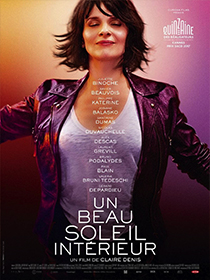 24. Let the Sunshine In
24. Let the Sunshine In
Director: Claire Denis
Making love is better when you’re in love. For Isabelle (Juliette Binoche), a painter living in Paris, the former comes easily and the latter vexes her. She has no trouble meeting men, falling for them, sleeping with them. They practically stumble into her orbit, then into her embrace, and she into theirs. When your sex life is rich but your love life poor, life itself tends gradually to lose overarching meaning, and the search for meaning is the engine driving Claire Denis’ new film, Let the Sunshine In, an ostensible romantic comedy that’s light on both but rich with soulful ennui. Not to say that Denis and Binoche don’t make us laugh, mind you, but what they’re really after is considerably more complicated than the simple pleasures the genre has to offer. Let the Sunshine In is a sexy film, a free, loose, yet rigorously made film, and yes, it’s occasionally a funny film, but primarily it’s a painful film, that pain deriving from primal amorous cravings that unfailingly slip through Isabelle’s fingers like so much sand. The film strikes us as straightforward when boiled down to its synopsis, but Denis layers conflicting human longing upon its rom-com framework. The blend of artistry and genre is breezy and dense at the same time, a film worth enjoying for its surface charms and studied for its deeply personal reflections on intimacy. You may delight in its lively, buoyant filmmaking, but you’ll be awed by the breadth of its insight. —Andy Crump / Full Review
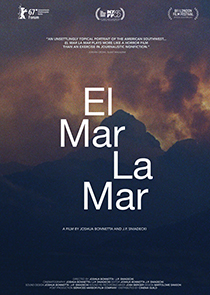 23. El mar la mar
23. El mar la mar
Directors: Joshua Bonnetta, J. P. Sniadecki
With the Sonoran desert an unforgiving canvas, Joshua Bonnetta and J. P. Sniadecki’s El mar la mar attempts to graft deeply personal stories across a vastly impersonal divide—namely, the U.S./Mexico border. Excising any guiding semblance of structure, the directors prefer to cast the voices of the region’s storytellers, telling tales from the absurd to tragic, sometimes against a completely black screen, the better to draw you in to that single voice trying only to let you know what’s going on there, in the dark. As Bonnetta and Sniadecki patch in ambient soundscapes, allowing the soft noise of a thunderstorm or the squeak and rustle of night creatures to seep into the picture, their camera lingers on stretched out, scorched landscapes. The effect is cumulatively gutting: They end up with a grainy pastiche of this godforsaken part of the world, nothing instructive, just a lasting, melancholy impression. El mar la mar may be a film about memory, but it resists regurgitation, instead about tragedy time-stamped for an eternity in the desert, about the immigrants who’ve crossed that desert to come to the U.S., about how the U.S. expects them to forget everything that came before, and about how the desert won’t let them. —Dom Sinacola
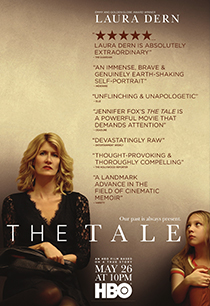 22. The Tale
22. The Tale
Director: Jennifer Fox
Jennifer Fox has just done something utterly brilliant, and you need to see it. Be prepared to feel uncomfortable, because The Tale, adapted from her narrative memoir of the same name, will do a number on your head, in the way that a particularly vivid nightmare sometimes can, whether you personally have a childhood sexual abuse story or not. This film was made three years ago. It’s not a response to or the property of any movement, any hashtag; it’s not finally, finally pulling back the veil on the terrible stories no one ever told until now. We have always told these stories. They have always existed and we have always told them. We just didn’t do it with hashtags. To even characterize this film as “a story about sexual abuse” would be a shallow read on a very deep work of art. The Tale is, at a certain level, “about” sexual abuse. But focus on that for too long and you’ll miss the astonishing, courageous, gorgeous mosaic of ways in which it is deliberately, doggedly and totally not. This is a film about the morphing quicksand terrain of human memory and it’s about the stories we tell ourselves in order to stay sane and most of all it’s about the Plinian, volcanic power of emotional honesty. If you want to talk about the spirit of the moment, the guiding spirit of the times, maybe we need to pan back from anything as specific as sexual abuse of girls and women and talk about why being honest is the ultimate act of revolution. Plenty of people make autobiographical films. The Tale is so deeply and specifically autobiographical that it almost becomes something else. Fox as director and writer puts her documentarian’s tools to work to create a meta-textual tapestry depicting the ways in which our memories inform (and misinform) our self-concept. And this beautiful, gripping, disturbing film deserves to be looked at with as much nuance as it offers. It manages to dive so deeply into the personal that it explodes into something universal. —Amy Glynn / Full Review
 21. Madeline’s Madeline
21. Madeline’s Madeline
Director: Josephine Decker
To call Josephine Decker’s Madeline’s Madeline “not for everyone” is to cheapen the enigmatic power of the film, which revolves around Madeline (Helena Howard), a young woman addressing her pronounced behavioral health issues via experimental theater and a hearty medication regimen. She maintains a fragile, temperamental home life with her mom, Regina (Miranda July), and bonds with her theater director, Evangeline (Molly Parker), on an equally maternal level. But the question of whether Evangeline actually has Madeline’s best interests at heart arises when the troupe’s roleplay exercises begin incorporating details of Madeline’s relationship with Regina. Madeline’s Madeline stages a tug-of-war between two people vying for governance over a girl searching for an identity to call her own. She is what others perceive her to be, until she isn’t, until she realizes she has all the control in the world over her sense of self. Shot through a disoriented lens and composed with alternatingly jagged and dreamlike edges, the film will leave you questioning how much of what you’re seeing on screen is “real” and how much is imagined. Call it heady, or avant garde, or bizarre, or opaque: Whatever your moviegoing proclivities, you won’t soon get this film out of your head. —Andy Crump
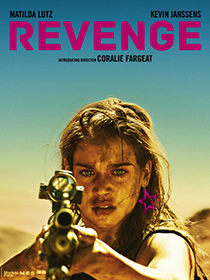 20. Revenge
20. Revenge
Director: Coralie Fargeat
In Coralie Fargeat’s Revenge, patience is a virtue of both storytelling and of vengeance. The film may have places to be, people to meet and blood to spill, but Fargeat takes her time all the same. She can afford the build up, in no small part because the build up is as pleasing as the payoff. “Pleasing” may seem at best an ignorant qualifier for a rape-revenge movie, but denying the pleasure of Revenge’s deliberate, exquisite filmmaking would mean denying Fargeat’s strength of vision, of that rare rape-revenge movie directed by a woman rather than a man. The innate ugliness of Revenge is crystallized by the shift in perspective. Not to knock I Spit on Your Grave, I Saw the Devil or The Virgin Spring, but seeing this particular niche through the eyes of Fargeat and her star, Matilda Lutz, gives the material a unique resonance without abandoning the genre’s underpinnings. Fargeat has more or less built Revenge to function as a feature-length chase sequence. This, along with the desert sands and sweltered aesthetic, will likely call to mind Mad Max: Fury Road for many. For others, the firmly French love of excessive gore places the story in the territory of movies like Inside, Haute Tension and Irreversible. Revenge could take place anywhere: Arizona, California—possibly Morocco, where the bulk of shooting took place. The elasticity of the film’s geography feels fitting. What happens to Lutz’s character can happen to any woman anywhere. —Andy Crump / Full Review
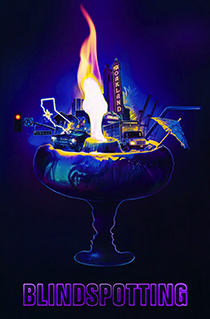 19. Blindspotting
19. Blindspotting
Director: Carlos López Estrada
Movies like Blindspotting, kitchen sink movies in the business of tackling as many subjects and relevant social issues as they can squeeze into two hours, tend to risk overstuffing: They try to be about everything, so end up being about nothing. Let Blindspotting serve as an object lesson in keeping the sink tidy and organized, its “about everything” narrative built around an anchor, being Oakland, that holds the “everything” in place, from police violence, to gentrification, to cultural appropriation and code switching, to workaday prejudice and systemic racism. Blindspotting is about Oakland first, the contemporary woes weighing Oakland down second and the overarching problems of the time we live in a close third. Above all else it is about the vigor of Daveed Diggs and Rafael Casal, its co-leads and authors, who, having spent nine years writing the script, have finally realized their vision, an ode to their hometown and a timelapse snapshot of America. The film is uplifted by Diggs’ and Casal’s raw talent as storytellers, poets and MCs—Diggs’ hyperkinetic rapping is one of the film’s best merits—but its backbone is a product of the emphasis put on its backdrop. —Andy Crump
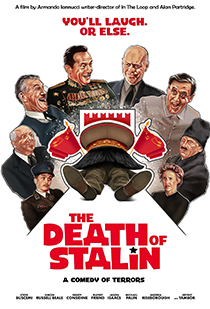 18. The Death of Stalin
18. The Death of Stalin
Director: Armando Iannucci
You can trace that dynamic from The Thick of It, through In the Loop and Veep, and then especially in his new film, The Death of Stalin, whose subject matter can be inferred from a mere glance. The Death of Stalin marks a major temporal departure for Iannucci, known for skewering contemporary political embarrassments and turmoil, by taking us back to 1953 Russia. Years out from the Great Purge, the country remains in the grip of widespread fear fomented by nationalism, public trials, antisemitism, executions, mass deportations and civic uncertainty. Iannucci asks us to laugh at an era not known for being especially funny. That’s the give and take at the film’s core: Iannucci drops a punchline and we guffaw, then moments later we hear a gunshot, accompanied by the sound of a fresh corpse hitting the ground. Finding humor in political violence is a big ask, and yet Iannucci’s dialogue is nimble but unfailingly harsh, replete with chafing castigations. We howl with laughter, though we can’t help feeling bad for every poor bastard caught on the receiving end of trademark Iannucci verbal abuse, which typically means we end up feeling bad for every character in his films. He spares no one from insult or injury, even when they’re lying dead on the floor, soaked in their own piss. A tale of mortal sins as well as venial ones, The Death of Stalin adds modern urgency to his comic storytelling trademarks: As nationalist sentiment rears its ugly head across the globe and macho authoritarian leaders contrive to hoard power at democracy’s expense, a farcical play on the political clusterfuck that followed Stalin’s passing feels shockingly apropos. It takes a deft hand and a rare talent to make tyranny and state sanctioned torture so funny. —Andy Crump / Full Review
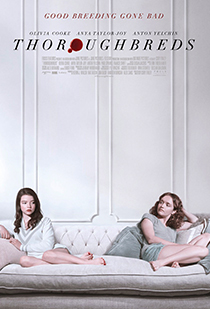 17. Thoroughbreds
17. Thoroughbreds
Director: Cory Finley
The line separating thrillers and horror films is razor thin. In the case of Cory Finley’s feature debut, Thoroughbreds, the former fits more suitably than the latter, but to take a page from Potter Stewart, I know horror when I see it, and Thoroughbreds toes that line with macabre confidence. The film isn’t particularly frightening, but makes up for that with suspense to harrow the soul. Thoroughbreds rattles us by pitting posh cultivation against human nihilism: When you’re scared, you tend to be scared in the moment. When you’re rattled, there’s no telling how long you’ll stay that way. That’s Thoroughbreds in a nutshell: A sobering, beautiful movie that’ll haunt you for weeks after watching it. Lily (horror queen ascendant Anya Taylor-Joy) is the epitome of high breeding: Impeccably dressed and made up, unflappably well-mannered, academically accomplished with a bright future ahead of her. Amanda (Olivia Cooke) is her polar opposite, a social outcast, friend to no one, possessed of a barbed tongue and a caustic temperament. They’re childhood chums who became estranged from one another over years, an everyday occurrence spurred by an incident involving Amanda’s family horse and an act of casual butchery. That all happens in the film’s past tense. In its present tense, the girls reconnect, Lily acting as Amanda’s tutor, and as they do the latter begins to rub off on the former and draw out her dark side. Lily and Amanda’s grim candor is couched in limited settings, primarily the grand house Lily lives in with her stepdad Mark (Paul Sparks) and her mother, but Thoroughbreds’ sense of confinement is a necessary component for its success as genre. Finley creates a space from which they can both break out, a gorgeous veneer akin to limbo. Within reason we can’t blame them for wanting to escape. Finley does a lot with very little apart from the raw talent of his leads. If this is what he’s capable of as a first-timer, we should rightfully dread his follow-up. —Andy Crump / Full Review
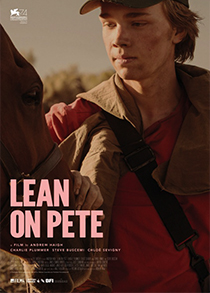 16. Lean on Pete
16. Lean on Pete
Director: Andrew Haigh
Lean on Pete flows with such gentle beauty that it may be hard to grasp precisely what it’s about or where it’s going. But the power of writer-director Andrew Haigh’s sublime drama is that it can support myriad interpretations while remaining teasingly mysterious—like its main character, it’s always just a bit out of reach, constantly enticing us to look closer. Based on Willy Vlautin’s 2010 novel, the movie is a smashing introduction to Charlie Plummer, who was the kidnapped John Paul Getty III in last year’s All the Money in the World. Here, he plays Charley Thompson, a 15-year-old living with his drinking, backslapping dad (Travis Fimmel) in Portland. Charley has a sweet face and a soft-spoken manner—when he talks, the last few words evaporate into the air, as if he’s too shy to even be bold enough to enunciate—but early on, we get a sense that there’s a craftiness underneath that demeanor. The first indication is his willingness to lie about his age to Del (Steve Buscemi), a craggy horse owner who reluctantly takes him on as a caretaker for his elderly racehorse Lean on Pete. Charley doesn’t know a thing about horses, but he’s anxious to find something to do now that he’s in a new town with his father, their reasons for leaving Spokane unspecified but clearly dispiriting. Familiar narrative tropes emerge in Lean on Pete: the boy-and-his-dog drama, the coming-of-age story, the father-and-son character piece, the road movie. Haigh breezes past them all, seeking something more elliptical in this deceptively slim story. With the patience and minimalist command of a Kelly Reichardt, he doesn’t dictate where his film goes, seemingly letting Charley’s restlessness call the shots. The boy’s journey gathers force and poignancy as it moves forward, and the more we understand about Charley the more unknowable he becomes. Along the way, we meet other people and see other worlds—the life of young military veterans, the reality of homelessness, the grind of the low-rent racing circuit—but Haigh views it all with the same unassuming compassion we see in Charley’s quiet eyes. —Tim Grierson / Full Review
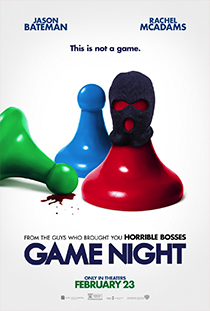 15. Game Night
15. Game Night
Directors: John Francis Daley, Jonathan Goldstein
What fuels fury more than fraternal frustration? In John Francis Daley and Jonathan Goldstein’s dark comedy Game Night, smarmily rich Brooks (Kyle Chandler) gifts his comfortably middle class and ultra-competitive younger brother Max (Jason Bateman) with the kind of immersive gaming experience that will change his life, primarily because it serves as an opportunity for Max to finally best his older bro at something for once. Max and his wife Annie (Rachel McAdams) are more than willing to play, as a tiny wedge in their marriage—their inability to conceive due to Max’s low sperm mobility, most likely brought on via anxiety caused by his brother—looms in the back of both of their minds. The comparisons between Game Night and David Fincher’s thriller The Game are apter than you think, not only because of the all-consuming nature of the game: Even if Max is a version of the same kind of petty as his brother is, the film reframes male virility within the context of a series of funny games. Meanwhile, Rachel McAdams is positively aces, her comic timing both precise and seemingly effortless, and duo Daley and Goldstein’s filmmaking is slick, allowing a light class critique (affluence is a scam) to sink in via glossy exteriors and shiny domestic spaces. Maintaining who we are and who we think we are is, for these characters, an unending, relentlessly competitive game. —Kyle Turner
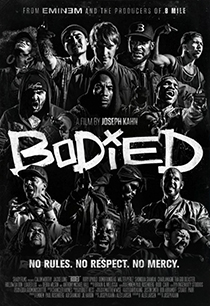 14. Bodied
14. Bodied
Director: Joseph Kahn
Timely-as-fuck, Joseph Kahn’s Bodied has faced an uphill battle for distribution since its conception, coming away from a select few festival showings with a yet-announced release date on YouTube Red, despite boasting Eminem as a producer and Kahn’s continued profile as a major music video director for Taylor Swift and Cardi B and every musician you’ve ever loved. About one college-aged ginger’s profanity-leaden odyssey towards cipher celebritydom, Bodied confronts pretty much every type of trigger—racism, sexism, classism, homophobia, commercialism, elitism, whatever, all filtered through an artistic expression retroactively, unapologetically shitting on them—with the delicacy of a wet fart, equally exhilarating and infuriating for it. As much about Adam Merkin’s (Calum Worthy) ascension from academic worshipping at the altar of KRS-One to title-holding battle rapper in his own right—the corpses of those who helped him along the way littered in his whitebred wake—as it is about the evolution of hip-hop as a full-on commodity, Kahn’s film pleads for discussion, for exactly the kind of Q&A that followed the showing during the Portland International Film Festival in February, with Kahn in attendance. Between white people standing up to list to Kahn their favorite rappers, and older couples congratulating Kahn on being so scintillating, conversations began, at least obliquely, that mostly involved viewers taking stock of themselves and where they belonged in the world of this vibrantly upsetting, wonderful, inviolably watchable screed. The director seemed satisfied, mostly opening up about how hard it was to get this movie out into the world, maybe too deep in the thing to see how hard it was for most of us, who’d just watched it and loved it, to understand why that was. —Dom Sinacola
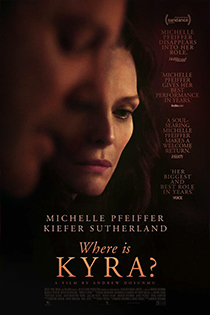 13. Where Is Kyra?
13. Where Is Kyra?
Director: Andrew Dosunmu
Kyra (Michelle Pfeiffer) has almost nothing left except for her mother. Back living at home in New York with no job and only the social security checks her mother lets her cash, everything is falling apart, Kyra herself falling into darker and darker recesses of her mind. Nigerian photographer and filmmaker Andrew Dosunmu spins Where Is Kyra? as not only a treatise against an oppressive capitalist system—much of the film is spent watching as Kyra schleps from one business to another in search of work nowhere to be found—but as a horror film about depression and, ultimately, possession. Dosunmu’s spaces are dark, clammy and claustrophobic, transforming both the apartment Kyra and her mother live in and Brooklyn itself into haunted houses, barren of joy and containing little else but ghosts and the distant remnants of possibility. With cinematography from Bradford Young, Kyra’s life is shrouded in blacks, greys and navys, Kyra sometimes barely discernible in the faint light. The worst parts of Kyra’s mother, and the worse parts of herself—deviousness, alcoholism, codependency—consume her entire identity, propelling her to do what financially stable people would consider unthinkable. Where is Kyra? may, in fact, be a monster movie: The unseen creature in the dark is poverty, caused by an unjust system, unseen and menacing. —Kyle Turner
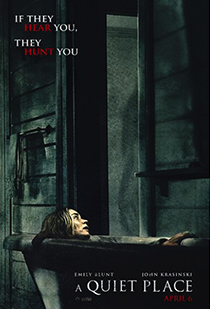 12. A Quiet Place
12. A Quiet Place
Director:
John Krasinski
A Quiet Place’s narrative hook is a killer—ingenious, ruthless—and it holds you in its sway for the entirety of this 95-minute thriller. That hook is so clever that, although this is a horror movie, I sometimes laughed as much as I tensed up, just because I admired the sheer pleasure of its execution. The film is set not too far in the future, out somewhere in rural America. Krasinski plays Lee Abbott, a married father of two. (It used to be three.) A Quiet Place introduces its conceit with confidence, letting us piece together the terrible events that have occurred. At some point not too long ago, a vicious pack of aliens invaded Earth. The creatures are savagely violent but sightless, attacking their prey through their superior hearing. And so Lee and his family—including wife Evelyn (Emily Blunt) and children Regan (Millicent Simmonds) and Marcus (Noah Jupe)—have learned that, to stay alive, they must be completely silent. Speaking largely through sign language, which the family knew already because Regan is deaf, Lee and his clan have adapted to their bleak, terrifying new circumstance, always vigilant to ensure these menacing critters don’t carve them up into little pieces. As you might expect, A Quiet Place finds plenty of opportunities for the Abbotts to make sound—usually accidentally—and then gives the audience a series of shocks as the family tries to outsmart the aliens. As with a lot of post-apocalyptic dramas, Krasinski’s third film as a director derives plenty of jolts from the laying out of its unsettling reality. The introduction of needing to be silent, the discovery of what the aliens look like, and the presentation of the ecosystem that has developed since their arrival is all fascinating, but the risk with such films is that, eventually, we’ll grow accustomed to the conceit and get restless. Krasinski and his writers sidestep the problem not just by keeping A Quiet Place short but by concocting enough variations on “Seriously, don’t make a noise” that we stay sucked into the storytelling. Nothing in his previous work could prepare viewers for the precision of A Quiet Place’s horror. —Tim Grierson / Full Review
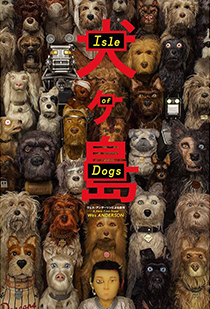 11. Isle of Dogs
11. Isle of Dogs
Director:
Wes Anderson
Isle of Dogs may be the closest Wes Anderson will ever get to a sci-fi film. Of course he would use stop-motion animation to make it. Set 20 years from now, amidst the ultra-urban monoliths of Megasaki City—a Japanese metropolis that also seems to be Japan, or at least a Westernized idea of the small island nation—the film begins care of a decree by Mayor Kobayashi (Kunichi Nomura), a boulder of a man with equal ties to an ancient lineage of cat-loving aristocrats and to, based on the elaborate back tattoo we glimpse atop his tight little butt in a quick bath scene, an archetype of organized crime and political corruption. Due to a vaguely described epidemic of “dog flu” (or “snout fever”), Kobayashi bans all dogs to Trash Island, a massive byproduct of technology and futurism, beginning with Spots (Liev Schreiber), the guard dog of 12-year-old Atari (Koyu Rankin), who also happens to be the Mayor’s ward after Atari’s parents died in a horrible accident. Since Bottle Rocket in 1996, the more manicured Anderson’s films have become—his obsessive control over his frames broadening into grander and grander worlds—the more we may be apt to extol his accomplishments rather than get invested in his stories. And it’s probably never been easier to do that than with Isle of Dogs, so rife with meticulousness and imagination, as is Anderson’s brand, and so unconcerned with steering this ostensible children’s movie towards actual children. For a director who pretty much defined a generation’s cinematic fetishization for symmetry (and quirky hipster nonsense) to then fetishize a country to which Westerners mainly relate through fetishization? So much of this beautiful movie just sort of eats itself. Still, the emotional weight of Isle of Dogs depends on knowing exactly what that bond between dog and human can mean, how deeply and irrationally it can go. At the core of Isle of Dogs is that kind of best-friendship: No matter how far we advance as a civilization, how disastrously we atomize and digitalize our lives, we’ll always have the devoted dependence of a dog, our immutable companion across the vast wasteland of human history. —Dom Sinacola / Full Review
 10. Avengers: Infinity War
10. Avengers: Infinity War
Directors: Anthony Russo, Joe Russo
Avengers: Infinity War is epic in a way that has been often aspired to but never fully grasped when it comes to the translation from comic book panel to the Big Screen. It’s what happens when moviemakers take their source material seriously, eschewing unnecessary melodrama even as they fully embrace the grandeur, the sheer spectacle, of it all. (And if there’s one lesson Disney has learned, it’s that if you focus on the viewer experience, the product lines will take care of themselves.) For every frenetic fight scene in Avengers: Infinity War—and there are plenty of them—there are myriad character interactions and emotional beats the audience has been prepped for by the previous films (okay, maybe not 2008’s The Incredible Hulk). As a result, writers Christopher Markus and Stephen McFeely have ample room to riff and play as characters meet for the first time or see each other again. Some of the interactions are easy to anticipate (if no less enjoyable)—the immediate ego clash between Cumberbatch’s Dr. Strange and Downey Jr.’s Iron Man, for example—but our familiarity with these characters adds resonance to nearly every scene and every line, as the vestiges and ripples of emotional arcs laid down in the last decade’s worth of movies bolster even the smallest moment. —Michael Burgin / Full Review
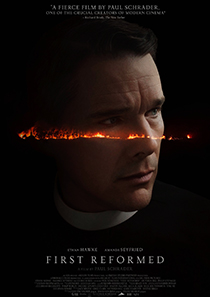 9. First Reformed
9. First Reformed
Director: Paul Schrader
What makes a man start fires? What if that person were a man of God? Paul Schrader, now 71, has perhaps spent his entire career as a filmmaker attempting to ask that question, to breach the impenetrable truth of whatever that question’s answer could be, beginning with Blue Collar, a story of auto workers and union members in Detroit compromising their values to survive in the shadow of forces too large and too immovable to compromise themselves. With First Reformed, Schrader’s 20th feature as director, that question absorbs the whole film—not through cries of nihilism, as in his previous, garbage Dog Eat Dog, but as a sustained act of faith: What must the devout do for a world God has abandoned? The question lingers wetly in Ethan Hawke’s eyes as he carries every frame of Schrader’s film. Playing Father Ernst Toller—a minister who in a former life had a wife and a son and a military career, an end brought to all three by that son’s death in Iraq—Hawke has spent the past 20 or so years sublimating the radical tendencies of his iconic slackerdom into a fiercely simmering anxiety, as if the purposelessness of his past malaise has left him stewing on how little he can or could do to change anything in this world. Not only does First Reformed directly butt heads with Dog Eat Dog, but it indulges melodrama without losing its calm. It works in obvious metaphors not for their own sakes, but as seamless extensions of theme. It’s a gorgeous film, mourning the impossibility of being alive as it celebrates that which binds us, a conscious-rattling, viscera-stirring piece of art. And ultimately, it’s a shocking film, powerful images gripping even more powerful fires within the bodies of those unequipped, as we all are, to put them out. —Dom Sinacola / Full Review
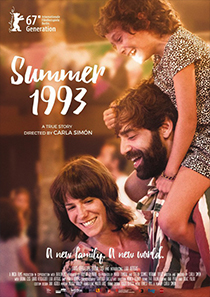 8. Summer 1993
8. Summer 1993
Director: Carla Simón
It’s against this backdrop of knee-jerk ignorance that Carla Simón has set her feature debut, the autobiographical drama Summer 1993, a movie about childhood marinated in confusion born from death. Her surrogate is Frida (Laia Artigas), six years old and, as the film opens, in the process of being whisked from her home in Barcelona to live in the countryside with her uncle, Esteve (David Verdaguer), and her aunt, Marga (Bruna Cusí, Spain’s Sally Hawkins doppelgänger), after her mother passes away from AIDS. It’s a chaotic scene shot from Artigas’s perspective, the camera latched to her alone, other characters appearing only when they happen to wander into the frame. Simón’s focal point is Frida, and remains such throughout the movie. The adult experience is tangential to her own. Simón’s cinematographer, Santiago Racaj, treats his lens as a member of the cast, too, impartial to the action without ever feeling removed from it. That dynamic has a way of subtly enhancing the film’s realism: Because Racaj and Simón are so involved, and so invisible, in their work, we inevitably feel more present in the story. Frida’s uncertainties become our own. Summer 1993 does what movies do so well (and yet so rarely do), which is to let viewers see the world through the eyes of another. Sometimes, Simón pulls this off literally, by angling Racaj’s camera upward, capturing the world from Frida’s vantage point. Most times she pulls it off figuratively by hanging the film on Artigas’ wonderful performance. But throughout she completely absorbs the viewer in this portrait drawn from her memories, painting a picture of Spain caught up in AIDS era disinformation that’s also an evocation of childhood doubts. —Andy Crump / Full Review
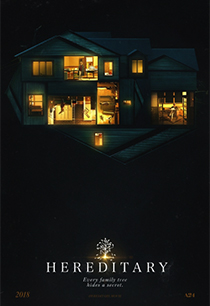 7. Hereditary
7. Hereditary
Director: Ari Aster
Ari Aster’s debut film begins in miniature. Later we learn of the trade Annie (Toni Collette), the film’s family’s matriarch, plies—meticulously designing doll-house-sized vignettes of the many domestic traumas she’s experienced, and still does, throughout her life, not for children but for art gallery spaces—though in the moment, in the beginning of Hereditary, the effect simply alludes to Aster’s ancestral preoccupations. From a tree house, pulling back through Annie’s workshop window, cinematographer Pawel Pogorzelski’s camera pans to a tiny recreation of the house we’re currently within, then pushes into the simulacrum of high school student Peter Graham’s (Alex Wolff) bedroom, which transforms into the room itself, perspectives already ruined so early in the film. Father Steve (Gabriel Byrne) enters to give his late-snoozing son the black suit needed to attend his late grandmother’s memorial. Aster’s intent, as is the case throughout Hereditary, is both blunt and oblique: worlds exist within worlds, shadows within that which casts them, or vice versa, reality represented like the rings of a tree or the spirals of DNA holding untold secrets within the cores of whoever we are. Colin Stetson’s brain-churning score rattles the frame’s edges. Menace looms—and menace soon unfolds, tragedies upon tragedies. The Graham family unravels over the course of Hereditary, which derives its power from testing the binds that force families together, teasing their strength as each family member must confront, kicking and screaming (or in Collette’s case: making the noise of one’s soul fleeing through every orifice), just how superficial those binds can be. In the absence of a reason for all of this happening, there is inevitability; in the absence of resolution there is only acceptance. —Dom Sinacola / Full Review
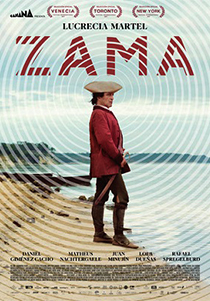 6. Zama
6. Zama
Director: Lucrecia Martel
Early in Lucrecia Martel’s Zama, her dreamy intent and languid images begin to nestle into place. First we witness Spanish corregidor (“mayor”) Don Diego de Zama (Daniel Giménez Cacho, whose eyes bear lifetimes of disappointment and resignation) on the shore of a nondescript river, in charge of a desolate Spanish colonial outpost in the middle of nowhere South America, though he seems to be more inhabiting it than litigating its quotidian. Catching a group of native women bathing, he steals a glance but is immediately found out, chased from the beach. Slapping one of the women to assert his dominance, Zama’s violent reaction feels preposterous, the response of a person with no control over himself, or his lot in life. This land rejects this sad man. Martel and cinematographer Rui Poças (whose worked with Miguel Gomes and, recently, with João Pedro Rodrigues on the exquisitely pretty The Ornithologist) dedicate nearly every frame to Zama’s melancholy maundering, though rarely allowing him the dignity to ever be the most interesting figure in any particular shot, that is, when they aren’t up close, searching his lined mug for something representing courage or assertiveness. Stranded in a thankless government job, not so much forgotten by the system as just avoided, Zama is a colonist renounced by both the colonized and colonizers. Zama is literally post-colonial: Colonists negate Diego de Zama’s colonialism by negating him, an equation Martel and Poças externalize by photographing with foreboding beauty the jungle around the pathetic man, reducing him to a meaningless, replaceable figure amidst effortlessly mighty landscapes. “Do you want to live?” Zama’s asked at the end of the film. He doesn’t respond. With her third film, Lucrecia Martel wonders, in wide swathes of unmitigated wilderness and weird, inexplicable poetry, just how far one’s wants can go. Bewitching and masterfully rendered, Zama is an elegant, ravishing, often delightfully strange achievement. It is reportedly the result of an interminable production process, of a difficult and substantial edit, of a novel that resists adaptation. It wants little more than to reach out in all directions, to peer into the void, knowing deep down that the void can’t be bothered to peer back. —Dom Sinacola / Full Review
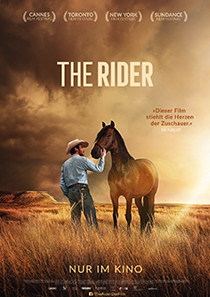 5. The Rider
5. The Rider
Director: Chloé Zhao
A dream dissipating. The Rider begins with flashes of a horse, in close-up, so intimately observed we immediately abandon all assumptions of symbolism or pretention of deeper meaning. Chloé Zhao’s second film invites social commentary and political dissection—it’s about the obsolescence of a certain way of life; about the death of toxic masculinity as exigency of a frontiersman’s spirit of adventure; about the failure of rural America to embrace an obvious socioeconomic future—but there’s nothing clearer, or more devastating, in The Rider than the bond between cowboy and horse. Said cowboy, and aforementioned dreamer, is Brady Blackburn (Brady Jandreau), a young, lithe South Dakotan rodeo rider still recovering from a head injury during one of his eight-second stints, a blurry accident we re-watch with Brady via YouTube video on his phone. With a cast of non-professionals basically playing themselves, Zhao rarely pushes her actors to too riskily delve into melodrama, or anything, for that matter, that might make them uncomfortable. Instead, in Jandreau and his family, Zhao discovers a beautiful, intuitive sense of calm, which she reflects in long, mournful shots of Dakotan vistas, so unhurried and unhindered by the boundaries of the screen that each interstitial segment—often of Brady contemplating the world before him as he stands, his hip cocked, before a magnificent sunset—feels overwhelming. What cinematographer Joshua James Richards can do with a camera bears the weight of countless filmmakers in thrall to the pregnant possibility of this marvelous continent. Every frame of this film speaks of innumerable lives—passions and failures and tragedies and triumphs—unfolding unfathomably. —Dom Sinacola / Full Review
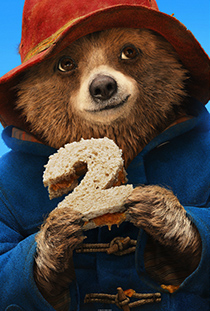 4. Paddington 2
4. Paddington 2
Director: Paul King
A sequel to 2014’s Paddington, Paddington 2 picks up where its predecessor left off, with Paddington Brown (né Bear and voiced by Ben Whishaw) living contentedly with his human family, including Hugh Bonneville (Downton Abbey) and a newly name-recognizable Sally Hawkins (The Shape of Water), joined by that British A-Lister of yore Hugh Grant, dramatic heavyweight Brendan Gleeson, and many others. (In fact, one of the simple joys for parents watching the film lies in recognizing this or that British actor.) A simple, commendable desire to find a good gift for his Aunt Lucy (currently spending her days in a nice retirement home for bears in Lima, Peru, natch) leads Paddington to set his eyes on a certain antique pop-up book as the perfect present. When that scoundrel and fading thespian Phoenix Buchanan (Grant) also sets his sights on the same book, well, hijinks, misunderstandings and adventure ensue. Paddington 2 reminds us how difficult it can be to pull off a sweetly tempered, gently moving children’s movie by doing exactly that, and doing it so well. —Michael Burgin / Full Review
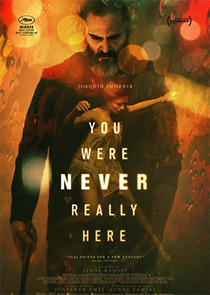 3. You Were Never Really Here
3. You Were Never Really Here
Director: Lynne Ramsay
Lynne Ramsay has a reputation for being uncompromising. In industry patois, that means she has a reputation for being “difficult.” Frankly, the word that best describes her is “unrelenting.” Filmmakers as in charge of their aesthetic as Ramsay are rare. Rarer still are filmmakers who wield so much control without leaving a trace of ego on the screen. If you’ve seen any of the three films she made between 1999 and 2011 (Ratcatcher, Morvern Callar, We Need to Talk About Kevin), then you’ve seen her dogged loyalty to her vision in action, whether that vision is haunting, horrific or just plain bizarre. She’s as forceful as she is delicate. Her fourth film, You Were Never Really Here—haunting, horrific and bizarre all at once—is arguably her masterpiece, a film that treads the line delineating violence from tenderness in her body of work. Calling it a revenge movie doesn’t do it justice. It’s more like a sustained scream. You Were Never Really Here’s title is constructed of layers, the first outlining the composure of her protagonist, Joe (Joaquin Phoenix, acting behind a beard that’d make the Robertson clan jealous), a military veteran and former federal agent as blistering in his savagery as in his self-regard. Joe lives his life flitting between past and present, hallucination and reality. Even when he physically occupies a space, he’s confined in his head, reliving horrors encountered in combat, in the field and in his childhood on a non-stop, simultaneous loop. Each of her previous movies captures human collapse in slow motion. You Were Never Really Here is a breakdown shot in hyperdrive, lean, economic, utterly ruthless and made with fiery craftsmanship. Let this be the language we use to characterize her reputation as one of the best filmmakers working today. —Andy Crump / Full Review
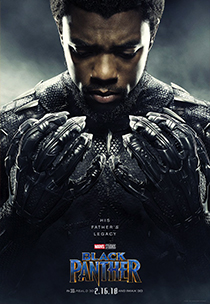 2. Black Panther
2. Black Panther
Director: Ryan Coogler
Black Panther might be the first MCU film that could claim to most clearly be an expression of a particular director’s voice. We shouldn’t go so far as to call it auteurist, because it’s still a Disney movie and (perhaps ironically) a part of that monopolizing Empire—i.e., eat the rich—but Black Panther’s action scenes, especially, feel one with Coogler’s oeuvre. Look only to an early scene in a South Korean casino, in which T’Challa (Chadwick Boseman), Okoye (Danai Gurire) and Nakia (Lupita Nyong’o) plan to intercept a deal between Klaue and everyone’s favorite CIA milquetoast, Everett Ross (Martin Freeman, lovable) for a vibranium-filled artifact which Klaue stole from some colonizer-run museum with Killmonger’s help. We’re introduced to Klaue through the surprising spryness of his violence—Andy Serkis, too, freed from mocap, is still an amazing presence, even as a gangster shitbag—and Coogler gets on his wavelength, carving out the geography of the casino in long tracking shots, much like he convinced us to love stained, shitty-seeming Philadelphia gyms in Creed by helping us to comprehend the many crevices and corners of each hole in the wall. When the casino brawl breaks out into the streets, morphing into a death-defying car chase (slow motion thankfully kept to a minimum), we feel as if we know exactly what these characters—and this wonderful director—are capable of. Cue magnificent Vince Staples track. —Dom Sinacola / Full Review
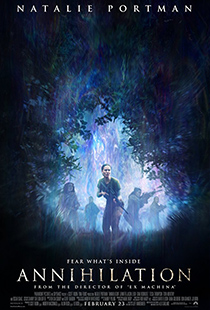 1. Annihilation
1. Annihilation
Director: Alex Garland
Annihilation is a movie that’s impossible to shake. Like the characters who find themselves both exploring the world of the film and inexplicably trapped by it, you’ll find yourself questioning yourself throughout, wondering whether what you’re watching can possibly be real, whether maybe you’re going a little insane yourself. The film is a near-impossible bank shot by Ex Machina filmmaker Alex Garland, a would-be science fiction actioner that slowly reveals itself to be a mindfuck in just about every possible way, a film that wants you to invest in its universe yet never gives you any terra firma to orient yourself. This is a film that wants to make you feel as confused and terrified as the characters you’re watching. In this, it is unquestionably successful. This is a risky proposition for a director, particularly with a big studio movie with big stars like this one: This is a movie that becomes more confusing and disorienting as it goes along. Garland mesmerizes with his visuals, but he wants you to be off-balance, to experience this world the way Lena (Natalie Portman) and everyone else is experiencing it. Like the alien (I think?) of his movie, Garland is not a malevolent presence; he is simply an observer of this world, one who follows it to every possible permutation, logical or otherwise. It’s difficult to explain Annihilation, which is a large reason for its being. This is a film about loss, and regret, and the sensation that the world is constantly crumbling and rearranging all around you every possible second. The world of Annihilation looks familiar, but only at first. Reality is fluid, and ungraspable. It can feel a little like our current reality in that way. —Will Leitch / Full Review
Let’s block ads! (Why?)


